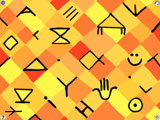Postcard from Tunis is not an objective documentary (if such a thing actually exists).
Instead, it's a playful, artistic exploration of writing: its histories, its inscriptions, its relationships with pictures and its relevance to the human-computer interface.
This is set in a very personal, audiovisual portrait of Tunis, the capital of Tunisia. This is a city and culture that I love, and the home of my former family-in-law.
I programmed the unique interface so that it echoes an actual visit, where you can't help learning a few Tunisian words and with time, maybe starting to read written Arabic.
Although it was designed for adults, children have shown a strong affinity with the CD-ROM and the interface is bilingual in English and French
Writing
The main theme of the work is writing, which, as this work demonstrates, seems to have no fixed boundaries distinguishing it from pictures.
See my 2003 PhD thesis for a full discussion of this idea. It is also developed and expressed in a subsequent work Postcards
From Writing 2004
The User Experience
In designing the interface for Postcard from Tunis, I stuck to the standard conventions (mouse-clicking, etc). However I substantially developed the rollover functionality by writing customized code. As a result, a user moves their cursor around the screen and creates an immersive experience of dynamic layered and linked sounds, music, images, animation and scripts.
The idea was to echo an actual visit. Users who don't speak Tunisian or read Arabic can't help learning a few spoken words and with time, possibly starting to read the Arabic script.
As these users interact with Postcard From Tunis they might begin to perceive the eight interleaved Tunisian words (eqiuvalent to Tunis, door, fish, writing, coka cola, coffee, camel and boat) as recognisable sounds, meaningfully linked to images and also to written Arabic.
These written Arabic words, for example the equivalent of the word Tunis on the left, may also seem to change from being beautiful but uninteligible "squiggles" to recognisable patterns linked with sounds. Later they may be perceived as written texts, recognisably made up of letters of the Arabic alphabet.
These apparent transitions highlight the lack of fixed boundaries between between writing and pictures, speech and noise. And for the user, the screen becomes a post card that they read, write and play as an instrument, creating multidimensional signs unique to human-computer interaction.
Sound is an integral part of the work. A considerable effort has been made to produce a continuous, high-quality stereo audio experience, using location recordings from Tunis and original music created by Lebanese musicians in Australia.
